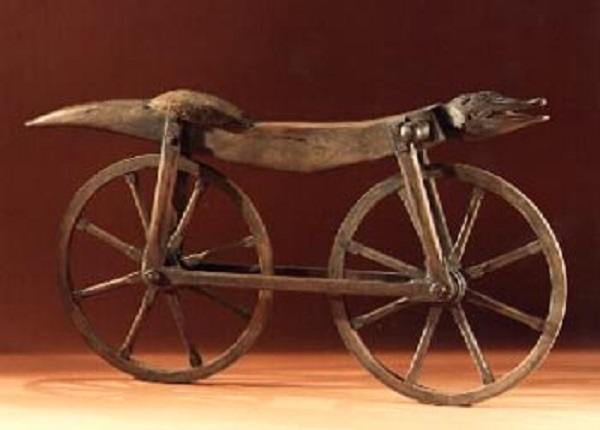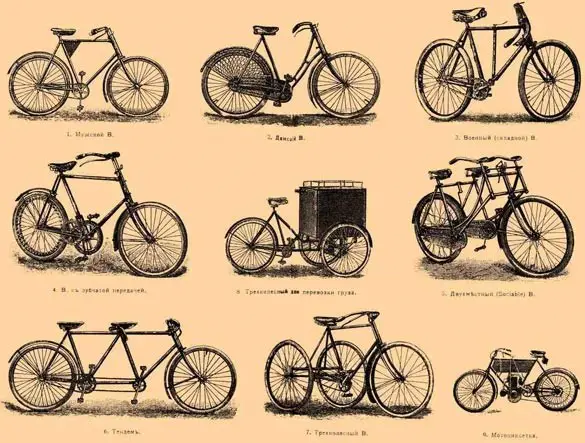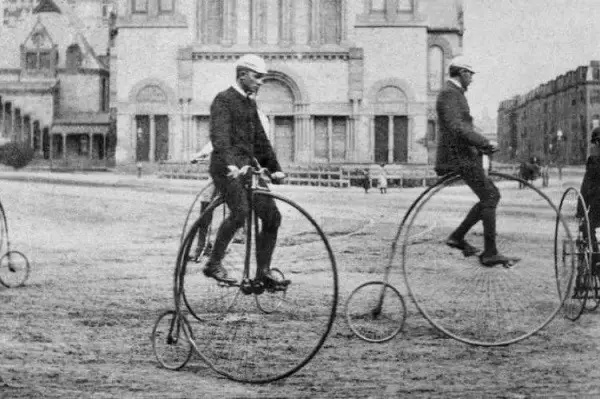The bicycle occupies a significant place in the life of many people. It is a means of transportation, a hobby, and a sport. But has the bicycle always been what it is today? Of course not. And it originated centuries ago and was not like today’s models. It was wooden. The first wooden bicycle amazed contemporaries of those years with its ability to travel many miles on it. Who was the first inventor of this wonderful form of transport? In what year was the first wooden bicycle invented? Let’s explore these questions together.
Was Leonardo da Vinci the creator of the first bicycle?
A drawing of the first bicycle was discovered at the University of Milan. The drawing was put on the back of a sheet with a drawing by Leonardo da Vinci, so no one doubted its authenticity at first. The diagram went around the world. The Italians were thrilled that their countryman had created the bicycle. But over time, the claim that the first wooden bicycle was invented by Leonardo da Vinci was disproved. According to the first version, the circles were drawn by a famous artist, and the frame and handlebars belong to the hand of an ordinary monk. The monks had jokingly added these elements to the circles. The second version is connected with the name of Hans Lessing. He researched the life and work of Lernardo da Vinci for many years. He claimed that the diagram was drawn by Carlo Pedretti, a scientist at the University of California.
Count Sivrak’s bicycle – truth or fiction
Some have attributed the invention of the first wooden bicycle to Count Sivrak. They called the device he created the “selerifer.” It consisted of two wheels connected by a bar. The front wheel was larger than the rear and did not turn. Therefore, the device moved only in a straight line, driven by human feet. In 1791, Count De Sivrak demonstrated the wonder of technology to the cheers of the delighted ladies. The stained-glass windows in the church of St. Egydius showed a scooter with a human figure towering over it. This was Sivrak’s scooter.
But some time later it turned out that the event described and the invention itself are a forgery invented by the journalist Louis Baudry in 1891. And Count Sivrak is considered a fictitious person. The Count’s prototype is Gene Sivrak, who imported four-wheeled carriages.
The legend of the peasant Artamonov
The creation of the bicycle was considered an important event around the world, so every state tried to appropriate its invention. France, Italy. England, China and other countries asserted their primacy in the invention of the first wooden bicycle.
The question of in what year the first wooden bicycle was invented, did not ignore and Russia. It is believed that the first wooden bicycle was created by the serf from Tagil region Yefim Artamonov, who rode 2,000 kilometers to Moscow on the instructions of his master Akinfy Demidov. He presented his invention during the coronation of Alexander I. The tsar liked the device so much that he gave freedom to the serf and his entire family. And the first bicycle is in the Nizhny Tagil Museum of Local Lore. If we consider 1801 to be the year of the invention of the first wooden bicycle, and its author – Artamonov, then it begs the question: why does it resemble a spider bicycle. The fact is that bicycles made of open-hearth steel in the form of a spider did not appear until 1870.
The device in the museum was subjected to chemical analysis and revealed that it was created from open-hearth steel of the last decade of the 19th century. No documents confirming Artamonov’s invention were found. The history of the Urals mentions the serf Kuznetsov-Zhepinsky, who was granted freedom by Alexander I for his invention, but it was not a bicycle.
Who invented the first wooden bicycle and when?
The first wooden bicycle was invented by Carl Drese in 1817. A patent was issued for the invention in 1818. Drez’s first wooden bicycle was two wheels with bare rims. Tires had not yet been invented. The wheels were connected by a frame. A steering wheel helped steer the design. There were no pedals on the scooter device.
Drez’s first wooden bicycle was called a jogging machine because it could be ridden by pushing off the ground with one’s feet and sitting on its frame. Baron Carl Drez ran his first race from Mannheim to Schwetzingen. He covered a distance of seven kilometres one way and seven kilometres the other in an hour. It happened in the summer of June 12, 1817.
Preconditions for the appearance of the first wooden bicycle
The year 1816 was a bad harvest. Abnormal phenomena occurred because of the volcanic eruption in Indonesia in 1815. There was famine and loss of livestock. To somehow survive, they began to slaughter horses. The need to travel long distances set the stage for a device that would replace horses. Walking on foot was uncomfortable and required a lot of time and effort. Such a device and became the first wooden bicycle, which appeared in the difficult year 1817, first in France, then gained popularity in England and spread to the United States.
It also became popular at the time because the cost of a horse far exceeded the cost of a scooter. It cost only 20 pounds, while a horse was sold for 1,900 pounds.
Reasons for banning the first bicycle in many countries
As time went on, the number of bicycles increased. Despite the patent, Baron Carl Drez hardly sold his invention because the design was so simple that any craftsman could make it. Some citizens could make it themselves. The time came when the hardest of times was over and the horse population was restored. Therefore, the need for riding bicycles was no longer necessary.
The bicycles were heavy. They weighed 23 kilograms. The roads at that time were broken up by carriages and so cyclists would ride out onto the sidewalk. They created a dangerous situation on it and on the road. On the sidewalk, they would run over the walking public, scaring them because they were speeding and couldn’t handle the controls. Pedestrians would run out onto the road, dodging cyclists. On the road, they could get hit by horse-drawn carts. This is why bicycles were forbidden in some countries for decades.
The fate of the inventor Drez
Karl Drez was born on April 29, 1785 in Karlsruhe, Germany. He graduated from the University of Heidelberg. In 1811 he became a forester. But after a while he had a desire to invent something. He first invented a typewriter that drew musical notation. The invention gained popularity because drawing lines was a tedious and difficult task.
Second, he created a four-wheeled bicycle. It was propelled by muscle power But at the Congress of Vienna it was heavily criticized. His critics pointed out that the four-wheeled machine was hard to push, moved slowly and was subjected to shocks. But Drez was a man who never got discouraged and always believed in his strength and his mind. Carl corrected all of the critics’ comments. Instead of four wheels, he made two and added a steering wheel. Thus appeared the first wooden bicycle. For it he received a royal prize.
To promote his invention, the baron went to travel around the world. For five whole years he showed what his design could do, attracting more and more bike enthusiasts. But disaster struck: his father became seriously ill. Karl had to return home. For the last moments of his life his father felt that his son loved him, was near him. He had time to see his son’s next invention – a typewriter. After his father’s death, his enemies began to fight over his property.
In 1937, Dreza suffered a stroke. After recovering, he moves to a hut in the woods and continues to do what he loves: inventing. He puts a bicycle on iron rails. This is how the word dresina got its new meaning, and the new device was used in practice for a long time. Drez’s other inventions were a 16-key typewriter and a meat grinder. The typewriter was the progenitor of Morse code.
In 1849, Carl von Drez supported the revolution. He gave up his title of nobility and began to call himself a citizen. Soon the revolution was suppressed. The inventor was declared insane. His property was taken away from him, his pension was deprived. Thus Carl Drez became a pauper. He died on December 10, 1851, in his hometown.
Macmillan’s bicycle.
A blacksmith from Scotland improved Drez’s model. This happened in 1839. His name was Kirkpatrick Macmillan. The pedal and saddle he contributed to the design improved the appearance and performance of the device. The pedals moved back and forth, moved by metal rods. As a result, the rear wheel moved forward. The saddle was placed between the wheels. The cyclist sat on it and controlled it. The front wheel was turned with a steering wheel. But McMillan’s improved model was not widespread.
How Lalman’s bicycle differed
In the same year another improved model appeared, similar to the Kirkpatrick model. The two inventors did not know about each other, but the ideas were identical. The difference in Pierre Lalman’s bicycle was in the design of the pedals. In Pierre’s car, they spun. The pedals were connected to the front wheel, not the rear wheel. The first wooden bicycle, invented by Carl von Drez, was given a second life, somewhat improved by other craftsmen.
The launch of the bicycle into mass production
In 1863, Pierre went to Paris. Lalman’s sample became interested in the industrialists Olivier, who offered to launch the device into mass production. Together with Olivier and Lalman, the engineer Ernest Michaux was involved in the production of the bicycle.
The carriage maker Michaud came up with the idea of making the frame not of wood, but of metal. Olivier changed the design of the frame. Until then, the frame stood strictly horizontally, as if the back of a horse was sitting on which the rider was seated. The crossbar was placed diagonally. Its upper part was at the level of the handlebar support and the lower one – at the level of wheel axles. This positioning of the crossbar facilitated quick stamping or making it from pipes in an industrial way. In 1886 Pierre Lalman patented the invention. Such bicycles were called bones because the riders experienced strong vibrations while riding them. They were difficult to ride for long periods of time.
Penny Farts
The year 1969 is famous for the appearance of bicycles of a new design. These bicycles were called penny-farthing or spider bicycles and were like coins of different diameters: penny – big, farthing – small coin. A big wheel gave the structure stability and steadiness. The penny-farthing was invented by Eugene Meyer. Penny-farthing bicycles were made on spokes, which reduced the weight of the wheel and improved balance. Only men could ride the penny-farthing, because you had to climb on it from behind, standing on a step, and ride it with your legs stretched out in different directions, which is impossible to do in a skirt.
The time when spider bicycles were invented was the time when such devices became popular. The penny-farthing was followed by the invention of bicycles for women. They had three wheels, so they were called tricycles. Instead of one big wheel, they had two. The saddle was between the wheels. The tricycles had chain gears, which improved the quality of their movement.
Tandem bicycles, in which a man sat behind a woman, also appeared. They were used for group rides out of town. A man and a woman would spin the wheels together while sitting next to each other. Penny-farthing reached speeds of up to 25 kilometers per hour, so they became popular with students, fashionable young people, and men of different ages. The large wheel made the design more stable.
But these devices were dangerous, because on turns the center of gravity was shifted and large wheels tilted to the side. Sometimes they tipped over, dragging the down-and-out cyclist along with them. The rear wheel was useless when braking. The brake was on the handlebars and over-pressing it caused the sitter to fly over the handlebars, entangling his feet in it. But regardless of the health hazards, penny-farthing remained popular for a long time. There was a need to improve the bicycle to make it safer.
The safe bicycle.
In 1885, the safety bicycle was invented. It was invented by a British mechanic, John Starley.
It had two wheels, like the “costotry”, and changed the frame and drive. The saddle was located on a vertical frame post. Underneath were the pedals. The diagonal frame reached the crossbar between the wheels. The front wheel had a fork with a brake. A chain gear went to the wheel. Starley’s bicycle was called the Wanderer, Rover in English. Sometimes it was called a safe wanderer, in Russia such bicycles were called bisiklets.
The safety bicycle became popular all over the world. Mass production of old models ceased. An automobile concern appeared, which was engaged in mass production of the bicycle. It existed until 2005. Riding bicycles became a regular occurrence. Not only men but also women rode bicycles. The bicycle suit for women appeared. It consisted of wide trousers to the knees, which passed into narrow pants. A blouse or hunting jacket was worn on top. Since 1895, women and girls began to ride on a safe bicycle, not embarrassed and not afraid of reproach. Thus the bicycle became an instrument of the social revolution.
The advent of pneumatic tires
Pneumatic bicycle tires were created by John Boyd Dunlop, an ordinary veterinarian. He treated animals in small villages. But Dunlop was an inventor by vocation. In 1888, he invented pneumatic bicycle tires. The roads in the 19th century were potholes and bumps, so it was impossible to ride over them without rattling and shaking. The wheels back then were bare metal or covered with thin rubber. John’s son loved to ride his bicycle and his father watched anxiously as his bicycle vibrated and shook on the rough road.
John Boyd Dunlop measured the diameter of the wheels, took an irrigation hose, cut it to length, and wrapped the wheels. To achieve some tightness, he covered the joints with a thick tarp. To avoid slippage, he put rubber over the tarp. Then he inflated the wheels with air. He first made pneumatic tires for his son’s tricycle and then for an adult model. Soon he received a patent for their creation.
A short time later, John Boyd Dunlop set up a company to produce pneumatic tires. The first tires were glued on the wheels. This method of attachment was not convenient, so research laboratories began to be created, which developed new quality tires and tested them. Tires were created for bicycles, cars, airplanes. The company grew. Its branches sprang up all over Great Britain. But in the 80s of the 20th century the company went into decline. It was divided among the leading corporations.
How Speed Shifting Worked
The shifting gears originated in 1903. They were represented by 2 sprockets on the rear wheel, one on each side. To change gears, you had to take the wheel and chain off and put them back on the other side. The shifting mechanism was unreliable. The chain would fall off and then get stretched. In 1950, there was a mechanism used on modern models of bicycles. This design was invented by Tullio Campagnolo.
The first Folding Bicycles
In 1878, the first folding bicycle was invented. It was created by William Grote. It was a folding penny-farthing. The big wheel consisted of 4 parts, which were stowed in a special case. The small wheel and rudder were also separated and folded. The frame was assembled in half. All segments were packed.
At the end of the 19th century, various folding bicycles began to appear: men’s and women’s, children’s and adults’. Many patents were issued for such designs. The folding bicycle whose invention was patented was the Michael Ryan bicycle. Its creation dates back to 1894. Two years later, the military Gérard and Charles Morel created their own design for an army folding bicycle. In 1896, William Crowe, a citizen of England, invented a light, elegant bicycle. It was similar to modern bicycle transformers.
The emergence of the Ligerad–what-it-is–types-and-benefits-of-recumbent-bikes.
The Ligerad–what-it-is–types-and-benefits-of-recumbent-bikes is the recumbent bicycle. This bicycle was invented by the American Brown. You can move on it half-sitting or sitting, lying down. They developed and continue to develop a high speed, because the air resistance is reduced. Ligegrids began to be produced in 1914. Another name for the ligégrade is the ricambent. The first ligegrass competitions were held in 1933.
Conclusion
The first wooden bicycle was invented by Baron Carl von Drese in 1817. The inventor himself called it a jogging machine, because it was possible to ride it quickly by pushing off the ground with the feet. The invention became popular. It was made by skilled craftsmen and ordinary citizens of different countries. They contributed to its design something of their own.
So with each decade the bicycle became safer and more popular. Pierre Lalman, Michaux and the Olivier brothers produced the devices in large quantities and helped popularize them among the population. The first wooden bicycle was replaced by the penny-farthing, the “boneyard,” and the safe skate bicycle. The bicycle changed its design: pedals, chain drive, gear shifting, pedal brakes, pneumatic tires appeared. Technical progress did not stand still. Folding structures were invented, ligegrads – recumbent bicycles. And finally, there were modern models, different types of devices: mountain, sports and others.
Decades will pass, and the best models of today will remain history. What will happen to the bicycle in the future, what new designs will be invented, we do not know. But maybe one of you or your children will be the inventor who brings something new to the evolution of the bicycle. We are sure that you will long remember the inventor of the first wooden bicycle, Baron von Drese, and his other followers.













